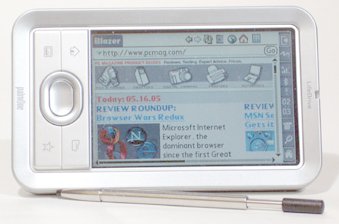Palm’s new LifeDrive has 4GB HDD — but where’s the Linux?
May 18, 2005 — by Henry Kingman — from the LinuxDevices Archive — views PalmOne is shipping its first harddrive-equipped PDA. Despite rumors the LifeDrive would run Linux, it runs Palm OS 5 (Garnet). However, the device seems to have a Linux-friendly design, and is likely to run Linux soon, whether supplied by PalmOne's sister company PalmSource, or by Linux hobbyists.
PalmOne is shipping its first harddrive-equipped PDA. Despite rumors the LifeDrive would run Linux, it runs Palm OS 5 (Garnet). However, the device seems to have a Linux-friendly design, and is likely to run Linux soon, whether supplied by PalmOne's sister company PalmSource, or by Linux hobbyists.
An early review at PC Magazine suggests that the LifeDrive has poor multi-tasking capabilities — traditionally a weakness of Palm OS, and a Linux strength. Potential open source software that could be ported to the LifeDrive include the OpenZaurus PDA operating system, and Trolltech's recently GPL'd Qtopia PDA application stack.
The LifeDrive is based on the Linux-friendly Intel XScale PXA270, clocked at 416MHz — the same processor used in Sharp's hard-drive equipped Linux PDA, the SL-C3000. The LifeDrive has 64MB of RAM, and a 4GB harddrive, with about 3.8GB available to the user. Harddrives are less expensive per GB than Flash storage, but are more easily damaged and less able to handle temperature extremes.
Unlike the Zaurus, the LifeDrive includes a built-in Wi-Fi radio. Wi-Fi stack specialist DeviceScape (formerly Instant802) says it helped PalmOne implement Wi-Fi, power management, and seamless roaming on the device, resulting in the first port of its Wi-Fi stack to Palm OS. DeviceScape adds that its Wi-Fi stack is used by the Wi-Fi Alliance in its test-bed, and that it is transitioning from an 802.11 service organization to a provider of off-the-shelf Linux Wi-Fi kits called Universal Wireless Platforms.

PalmOne's LifeDrive offers a half-VGA color display
Additional features
Additional features of the LifeDrive include:
- SD, SDIO, MMC slot
- 320×480 transflective TFT display with 65K colors
- Bluetooth 1.1 radio
- Horizontal or vertical orientation
- Media player
- MS Office file reader
- Browser/email/mms/PIM etc
Linux on the way?
PalmSource did not immediately comment on plans to offer a Linux-based OS for the LifeDrive. However, it seems likely that a Linux upgrade option is in the works.
PalmSource announced in December that it would migrate to Linux as a way of escaping the “Palm-compatible” hardware niche — a niche that it now appears hardware partner PalmOne is also working to escape. PalmSource then announced a Linux-based software stack for smartphones, before joining the Consumer Electronics Linux Forum (CELF).
PalmSource says new Palm applications written with the Cobalt API can be rejiggered to run on Linux with little more than a re-compile. The company is currently developing a library translation layer to enable older Palm apps based on the Garnet API to run on Linux as well. Once PalmSource has a Linux OS capable of supporting the huge variety of legacy Palm apps, look for a Linux OS upgrade to the LifeDrive.
To learn more about the LifeDrive, check out PC Magazine's early review:
This article was originally published on LinuxDevices.com and has been donated to the open source community by QuinStreet Inc. Please visit LinuxToday.com for up-to-date news and articles about Linux and open source.